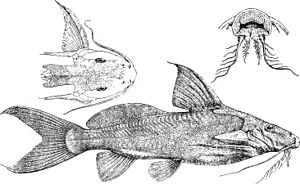Synodontis depauwi facts for kids
Quick facts for kids Synodontis depauwi |
|
|---|---|
 |
|
| Conservation status | |
| Scientific classification | |
| Genus: |
Synodontis
|
| Species: |
depauwi
|
The Synodontis depauwi is a type of upside-down catfish. It is special because it is only found in the Democratic Republic of the Congo, specifically in a place called Stanley Pool. A scientist named George Albert Boulenger first described this fish in 1899. He found it in Stanley Pool. The second part of its scientific name, depauwi, honors Louis De Pauw, who was in charge of collections at the Free University of Brussels.
Contents
What Does Synodontis depauwi Look Like?
Like other Synodontis catfish, S. depauwi has a strong, bony head. This bony part goes all the way back to its first fin on its back. It also has a unique bony bump on its shoulder area called a humeral process. The shape and size of this bump help scientists tell different Synodontis species apart. For S. depauwi, this bump is much longer than it is wide. It has a ridge underneath and a sharp point at the end.
Its Whiskers and Mouth
This fish has three pairs of whiskers, which are called barbels. One pair is on its upper jaw, and two pairs are on its lower jaw. The upper whiskers are long and straight. They do not have branches and can be about 1.25 to 1.33 times the length of its head.
The outer pair of lower whiskers is two to three times longer than the inner pair. The outer whiskers have small, thin branches, while the inner ones have even smaller branches.
On the very front of its upper jaw, the Synodontis catfish has a special pad of teeth called a premaxillary toothpad. This pad has several rows of short, chisel-shaped teeth. In S. depauwi, this toothpad is short and wide. On its lower jaw, the teeth are attached to flexible, stalk-like structures. These teeth are curved, almost like an "s" shape. The number of teeth on the lower jaw helps tell species apart. S. depauwi has about 30 to 35 teeth on its lower jaw.
Its Fins and Tail
The front edges of the fins on its back (dorsal fin) and its side fins (pectoral fins) are hard spines. For S. depauwi, the spine on its dorsal fin is about two-thirds the length of its head. It is mostly straight, sharp on the front, and has a saw-like edge on the back. The rest of the dorsal fin has seven soft, branching rays.
The spine of its pectoral fin is a bit longer than the dorsal spine. It has saw-like edges on both sides. The small, fleshy fin (adipose fin) is about 3.5 to 4.5 times longer than it is tall. The fin on its belly (anal fin) has three unbranched rays and seven or eight branched rays. Its tail, or caudal fin, is deeply forked, and the upper part is longer than the lower part.
Color and Size
The body of S. depauwi is a plain brownish color. Its fins have black spots, and there is a black stripe along each part of its forked tail. Young fish might have dark, marbled patterns on their sides.
This fish can grow up to about 24 centimeters (9.4 inches) long. Generally, female Synodontis fish tend to be a little bigger than males of the same age.
Where Does Synodontis depauwi Live?
In the wild, this fish is found in Pool Malebo. It has also been seen in the Kasai River basin and the Kwango River basin. People catch and eat this fish.
How It Reproduces
Scientists do not know much about how most Synodontis species reproduce. They have found eggs inside some female fish. It is thought that they probably lay their eggs during the flooding season, which is usually between July and October. When they lay eggs, pairs of fish likely swim together. Young fish grow very quickly in their first year, but their growth slows down as they get older.


